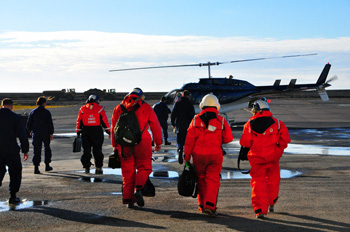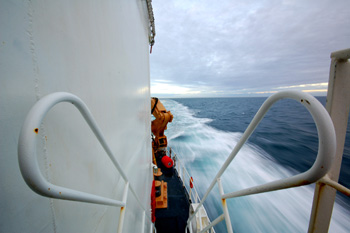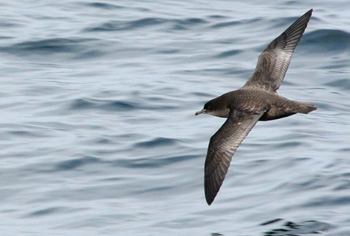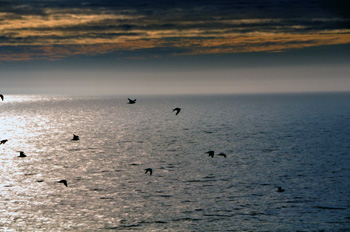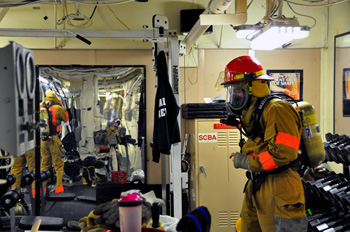September 7th
We’re underway now in glowering weather and persistent east wind driving the temperature down around 25 degrees F. “You’d think we were in the Arctic,” someone said. Embarkation was a major production. Four by four we donned cold-water survival suits and helmets and flew by helicopter from Barrow out to the Healy. Arriving on the flight deck, we doffed suits and helmets and passed them to debarking science party for their flight back to Barrow. That’s how it goes on this and other Arctic research vessels. Ship time is so valuable, so tightly scheduled there is little or no downtime; one party out, the next in. Who can blame the crew for being less excited about our presence aboard than we are? It took half the day to transport the people and their gear—and the remainder to fly in the food. Ten days ago, the Healy crew, at sea since May, ran out of vegetables and other fresh stores. (Over dinner, an ensign delightedly consuming a salad observed, “It feels like Christmas.”) Most of us wandered around the ship, far larger than any I’m used to, lost and befuddled in cul-de-sac corridors on multiple decks only to end up back where we began. But her layout grows clearer now, the research-vessel routine is taking hold, and it feels good to be at sea again. So now might be an appropriate time to talk about the shape and purpose of the cruise. Dr. Bob is a physical oceanographer; they measure oceans. But Bob is keenly aware that ocean, atmosphere, ice, all the birds of the air, and all ocean creatures from the tiniest particle of phytoplankton to the great whales are connected and interdependent—that nature in all its myriad forms, all its complexity and diversity is in effect a single unity.
It’s only relatively recently that we’ve learned to think about living organisms in the context of their ecosystems. You can’t understand the animal without understanding its habitat, but its more than that. It’s an ecosystem, suggesting movement and interaction among all things living in a particular region, i.e. forests, deserts, coral reefs, tundra, etc. A species that over time has adapted to conditions in one ecosystem would not survive in another. Likewise, if conditions changed too extensively or abruptly within specific ecosystems—if, say, the ice melts in the Arctic—then the ice-adapted organisms within that ecosystem must re-adapt or die. Still more recently, however, we’ve learned that individual ecosystems are not isolated islands of life separate from and impervious to changes in other ecosystems. All are dependent for survival on the stability of the climate. We’ve also learned of late that climates change far more rapidly than once we thought, and that the mechanisms for change are actually inherent to climate systems. Let’s take sea ice for example. Ice is white. White things reflect solar radiation. In unscientific terms, white things send the sun’s radiation back from where it came, and so, all things in balance, the surface of the sea remains cold and ice-covered. However, if sea and/or air temperature increase enough to initiate melting, then dark ocean water will be exposed to the sun. Dark things absorb solar radiation. (That’s why desert people wear light-colored clothing.) The resulting warming melts more sea ice, exposing more dark water, which causes still more warming. Once that feedback process gets rolling, it’s hard to stop. If the process continues thus, then eventually the ice will go out of Arctic, and ice-adapted animals—polar bears, seals, whales, etc—will have to change their way of life or die. The ocean does wondrous things simply because the sun shines, the wind blows, and Earth rotates. So melting sea ice will have a destructive effect on an environmental level. But it will also have effects reaching far beyond the local environment. Vanishing sea ice will likely cause global-wide climate change when the altered sea and air are transported by winds and currents into multiple environments. Highly simplified, of course, this version still illustrates the point that almost nothing in the natural world happens without cause or without result on something else. Therefore understanding conditions and mechanisms in a particular environment, let alone in global climate, requires multi-layered, multi-discipline research. That is both the theme and purpose of this expedition. And that is why Dr. Bob has encouraged young scientists from various fields to accompany him to the Beaufort Sea. * * *
“That’s a short-tailed shearwater,” said Brian, an ornithologist surveying sea birds for U.S. Fish and Wildlife, “our bird man,” as we call him. He has claimed a space on the port side of bridge (about the size of a tennis court) 66-feet above the water. According to firm bird-observation protocol, he counts and identifies birds that pass within a 90-degree arc 300 meters from the port side of the ship. That way, since he knows the position of the ship at all times, he can know precisely where the bird was when he observed it. “Shearwaters are members of the albatross family, but these guys, the short tails, spend austral summers in Tasmania and migrate here in our summer, halfway around the world.” Why? “Food. They get the best of both hemispheres.” Environmental conditions, Brian explained as he scanned sea and sky, determine bird habitat and range. “They go where the food is, and the ocean determines that.” “Look there,” said Melinda, an ice observer who’s assisting Brian, pointing to bevy of small birds paddling furiously to get out of Healy’s way. “Crested auklet,” said Brian consulting his reference book. “It says they shouldn’t be here. That shows how little bird work’s been done in these waters.” * * * Additionally, Dr. Bob is accompanied by marine-mammal scientists, another scientist gathering and examining plankton, a meteorologist, an ocean chemist, and others; we’ll talk with all of them as the trip goes on. By its close, we’ll know much more about the ecology of the Beaufort Sea.
However, the root and essence of this high-latitude environment—and a major determinant of climate here and everywhere else—is the ocean. And this at bottom is an oceanographic expedition. We must give the ocean the attention it deserves, even though physical oceanography requires of us non-scientists a bit of effort to cast our minds across great distances and into great depths to visualize that which we cannot see. But it’s worth the effort. The ocean does wondrous things simply because the sun shines, the wind blows, and Earth rotates. Guys in full fire-fighting gear dragging hoses just rushed past the lab door, and smoke is gathering in the corridor. Gives you a start at first glance, but we’re not worried. They said it was just a drill. Last updated: September 28, 2010 | |||||||||||||||||||||||
Copyright ©2007 Woods Hole Oceanographic Institution, All Rights Reserved, Privacy Policy. | |||||||||||||||||||||||
